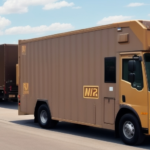Maximizing Your Budget Economy Shipping Options
Understanding Economy Shipping Options
When shipping products on a budget, selecting the right economy shipping option is crucial to balancing cost, quality, and reliability. The most common economy shipping methods include:
- Ground Shipping: Typically the most affordable option, suitable for non-urgent packages with delivery times ranging from 2 to 7 business days. Ideal for domestic shipments within the same country. According to the United States Postal Service, ground shipping can save businesses up to 30% compared to expedited services.
- Standard Shipping: Offers faster delivery than ground shipping, usually within 1 to 5 business days. It is slightly more expensive but provides a better balance between cost and speed.
- Freight Shipping: Best for bulky or heavy items that are not feasible to send via traditional parcel services. Freight shipping options can handle large volumes and weights, often with more flexible scheduling.
- Expedited Shipping: While not always classified as economy, some carriers offer discounted expedited services that deliver within 1 to 3 business days. This option is suitable for urgent packages without the high costs of premium services.
- International Shipping: For packages destined outside the country, economy international shipping provides a cost-effective solution, though it typically involves longer transit times and additional documentation, such as customs forms.
Choosing the Right Shipping Option for Your Budget
Selecting the appropriate shipping method involves evaluating several key factors:
- Package Dimensions and Weight: Heavier or larger packages may incur higher costs, making ground or freight shipping more viable.
- Destination Distance: Longer distances generally increase shipping costs and transit times. Utilizing regional carriers can often reduce expenses.
- Delivery Time Requirements: Assess whether the shipment is time-sensitive. Balancing speed with cost is essential for budget management.
- Carrier Comparison: Different carriers offer varying rates and services. Tools like the FedEx Shipping Calculator or UPS Shipping Rates can help compare costs and delivery times.
Additionally, many carriers provide discounts for high-volume shippers. It's beneficial to inquire about bulk discounts or business accounts to further reduce shipping expenses.
Tips for Saving Money on Shipping Costs
Implementing strategic practices can lead to significant savings on shipping costs:
- Optimize Packaging: Use appropriately sized boxes to minimize dimensional weight charges. Lightweight and compact packaging reduces overall shipping costs.
- Negotiate Rates: Engage with multiple shipping carriers to negotiate better rates based on your shipping volume. Leveraging partnerships with third-party logistics providers (3PLs) can also secure favorable pricing.
- Utilize Flat-Rate Shipping: Some carriers offer flat-rate options, allowing you to ship items of specific sizes and weights at a fixed price, which is especially cost-effective for bulky items.
- Take Advantage of Discounts and Promotions: Carriers frequently offer seasonal promotions or discounts for specific shipping needs. Regularly monitor and utilize these opportunities to lower costs.
Reducing Shipping Times with Economy Options
While economy shipping is cost-effective, reducing delivery times without significantly increasing costs is achievable through various strategies:
- Selective Expedited Shipping: Apply expedited shipping only to urgent packages while utilizing economy options for standard shipments. This approach optimizes overall shipping costs.
- Leverage Technology and Automation: Implement shipping software that integrates with multiple carriers to automate and streamline the shipping process. This can enhance efficiency and reduce errors, leading to faster processing times. Tools like ShipStation offer comprehensive shipping solutions.
- Partner with Local Carriers: Regional or local carriers may offer faster delivery within specific areas at lower costs compared to national carriers.
Managing Risks and Benefits of Economy Shipping
While economy shipping offers substantial cost benefits, it's essential to understand and mitigate the associated risks:
- Benefits:
- Cost Savings: Significant reduction in shipping expenses, making it ideal for budget-conscious businesses.
- Bulk Shipping Discounts: Economies of scale can lead to lower per-unit shipping costs for large volumes.
- Risks:
- Longer Delivery Times: Delays may impact customer satisfaction, particularly for time-sensitive shipments.
- Limited Tracking and Insurance: Economy options might offer less comprehensive tracking and lower insurance coverage, increasing the risk of loss or damage.
- Potential for Damage: Cost-saving measures may sometimes compromise packaging quality, leading to product damage.
To mitigate these risks, ensure proper packaging, consider additional insurance for valuable items, and select reputable carriers known for reliability.
Calculating Shipping Costs and Staying Within Budget
Accurately calculating shipping costs is fundamental to maintaining budgetary control:
- Factors Affecting Costs:
- Weight and Dimensions: Heavier and larger packages typically cost more to ship.
- Destination: International shipments and remote destinations may incur higher fees.
- Carrier Rates: Different carriers have varying pricing structures based on services offered.
- Additional Fees: Charges like fuel surcharges, residential delivery fees, or insurance can add to the total cost.
- Utilize Shipping Calculators: Tools provided by carriers, such as the FedEx Rate Finder or UPS Rate Calculator, help estimate shipping costs based on package details.
- Optimize Packaging: Selecting the right packaging materials and minimizing excess can reduce both weight and dimensional volume, leading to lower shipping costs.
Best Practices for Packaging and Ensuring Safe Transit
Proper packaging is vital to protect your items during transit and reduce the risk of damage:
- Use Sturdy Packaging Materials: Invest in high-quality boxes, padding materials like bubble wrap or packing peanuts, and secure sealing tapes to reinforce package integrity.
- Distribute Weight Evenly: Place heavier items at the bottom of the box with lighter items on top to prevent shifting and deformation during handling.
- Label Packages Appropriately: Clearly mark packages with fragile symbols or handling instructions to alert carriers to handle with care.
- Specialized Packaging: Use leak-proof containers for liquids, anti-static materials for electronics, and custom packaging for uniquely shaped items to ensure optimal protection.
Tracking Shipments and Ensuring On-Time Delivery
Maintaining visibility over your shipments is essential for ensuring timely delivery and customer satisfaction:
- Carrier Tracking Services: Most carriers provide tracking numbers that allow you to monitor the progress of your shipments in real-time. Utilize these services to stay informed about your package status.
- Shipment Tracking Software: Integrate advanced tracking systems like AfterShip or ShipHero to consolidate tracking information across multiple carriers, providing comprehensive visibility and alerts for any delays or issues.
- Choose Reliable Carriers: Research and select carriers with a proven track record of punctuality and customer satisfaction. Access performance metrics and customer reviews to make informed decisions.
Effective communication with customers about their shipment status, including providing tracking information and estimated delivery dates, enhances transparency and trust.
Negotiating Better Rates with Shipping Carriers
Securing favorable shipping rates is achievable through strategic negotiations and partnerships:
- Leverage Shipping Volume: Higher shipping volumes often qualify for discounted rates. Consolidate shipments where possible to increase volume and bargaining power.
- Review and Compare Carriers: Regularly assess your shipping needs and compare rates from multiple carriers to ensure you're receiving the best possible pricing.
- Partner with Third-Party Logistics Providers (3PLs): Collaborating with 3PLs like ShipBob or Flexport can provide access to negotiated carrier rates and additional logistics services, further reducing costs and improving efficiency.
- Negotiate Contract Terms: Engage in discussions with carriers to negotiate terms that align with your business needs, such as payment terms, delivery guarantees, and volume discounts.
By implementing these strategies, businesses can effectively lower their shipping expenses while maintaining reliable and efficient delivery services.




















